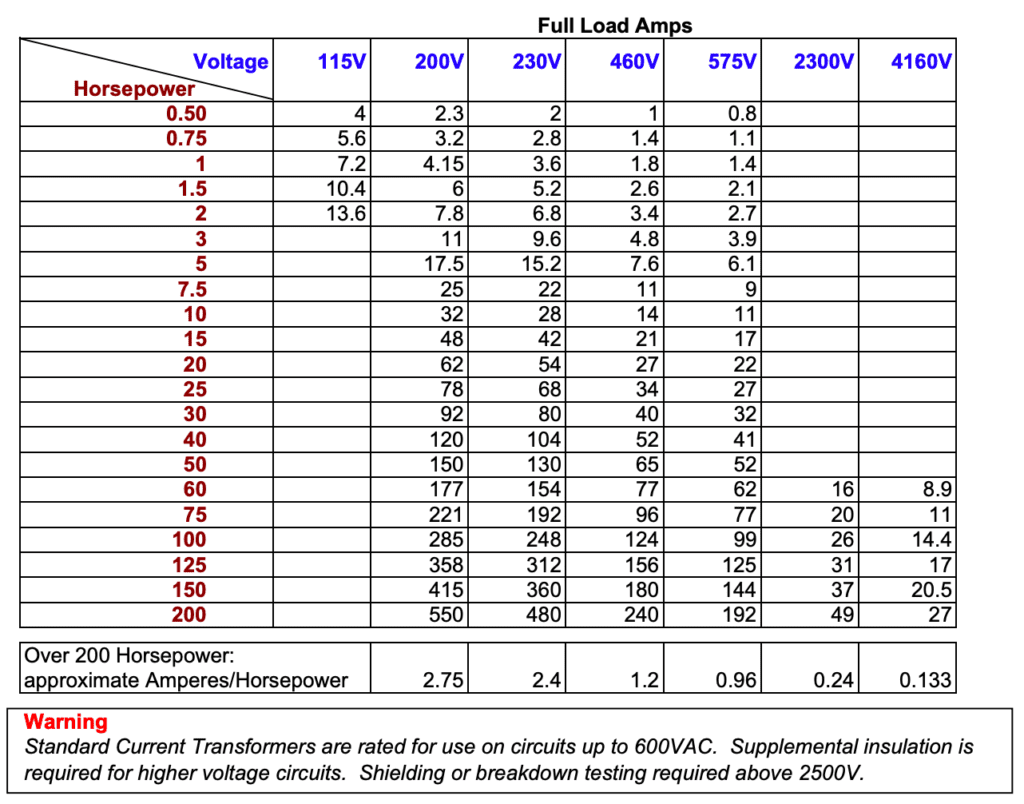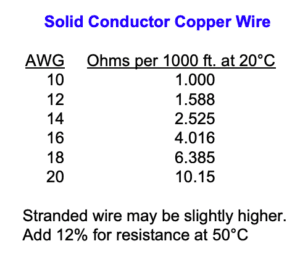Use this chart to select the CT rating for various motor sizes. This chart applies to three-phase AC induction type, squirrel cage and wound rotor motors.

To determine the correct current transformer rating, multiply the full load amperes by a factor of 1.25. This places the full load current above 2/3 full scale on the CT, while allowing sufficient headroom to also read overload conditions.
Example:
Horsepower = 200, Voltage = 230
Chart value of 480A multiplied by 1.25 = 600A. Closest standard current transformer ratio is 600/5.
Example over 200 horsepower:
Horsepower = 275, Voltage = 460
Chart value of 1.2A/HP multiplied by 275 HP = 330A. 330A X 1.25 = 412.5A. Closest standard current transformer ratio is 400/5.
For single-phase motors, determine full load current from the nameplate rating. Multiply by 1.25 to get the approximate CT rating, as shown above.
Next Steps:
Verify that the window size on the CT is adequate for the motor wire or bus bar.
Determine input resistance (burden) of the meter or transducer.
Measure the distance from the current transformer to the meter or transducer.
Refer to the CT wire length chart for the required VA rating and wire gauge.
Notes:
The wire length chart is valid for a meter input resistance <0.02Ω. This is adequate for most analog meters with an iron vane movement. Rectifier type analog meters and digital meters typically have a higher input resistance. Consult the manufacturer’s specifications for the exact value. If the input resistance is >0.02Ω, heavier wire or a higher VA rating will be required.
The distance measurement must follow the path of the wire, including any bends and diversions. This is often considerably longer than the line of sight distance between the devices.
When determining allowable lead resistance, including the resistance of any intermediate connectors or terminations. Wire nuts or crimp terminals can add significant resistance.
Examples:
The secondary rating of a 2SFT-101 is 2VA.
If the wire path from the CT to the meter is 6 feet, the total circuit is 12 feet.
When using an iron vane meter with <0.02Ω input resistance, the chart value can be read directly.
16 AWG wire is required for this CT.
If smaller wiring is already in place (e.g. #18 AWG), a larger CT is required (e.g. 3VA).
Using the same transformer with an iron vane meter at a distance of 30 feet (60 ft circuit length) would require 10AWG wire.
 Using a digital meter with a burden of 0.2V at 5A gives an input resistance of 0.04Ω.
Using a digital meter with a burden of 0.2V at 5A gives an input resistance of 0.04Ω.
The 2SFT-101 transformer maximum is 0.08Ω, which leaves only 0.04Ω for lead resistance.
From the Copper Wire chart, #16 AWG wire has a resistance of 0.048Ω in the 12-foot circuit (at 20°C).
#14 AWG wire has a resistance of 0.030Ω in the 12-foot circuit at 20°C and 0.034Ω at 50°C.
Both values are below the 0.04Ω limit (assuming no additional resistance from intermediate connections).
